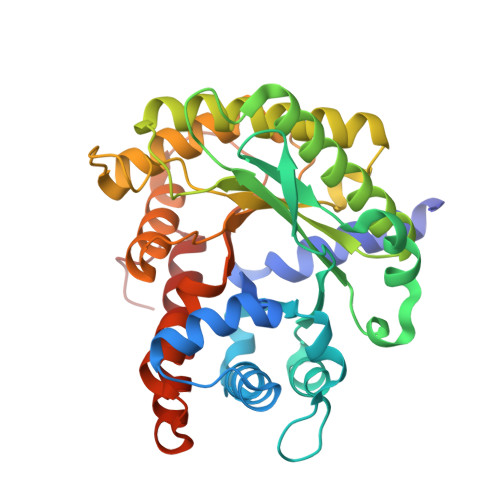Structure of fructose bisphosphate aldolase from Encephalitozoon cuniculi.
Gardberg, A., Sankaran, B., Davies, D., Bhandari, J., Staker, B., Stewart, L.(2011) Acta Crystallogr Sect F Struct Biol Cryst Commun 67: 1055-1059
- PubMed: 21904050
- DOI: https://doi.org/10.1107/S1744309111021841
- Primary Citation of Related Structures:
3MBD, 3MBF - PubMed Abstract:
Fructose bisphosphate aldolose (FBPA) enzymes have been found in a broad range of eukaryotic and prokaryotic organisms. FBPA catalyses the cleavage of fructose 1,6-bisphosphate into glyceraldehyde 3-phosphate and dihydroxyacetone phosphate. The SSGCID has reported several FBPA structures from pathogenic sources. Bioinformatic analysis of the genome of the eukaryotic microsporidian parasite Encephalitozoon cuniculi revealed an FBPA homolog. The structures of this enzyme in the presence of the native substrate FBP and also with the partial substrate analog phosphate are reported. The purified enzyme crystallized in 90 mM Bis-Tris propane pH 6.5, 18% PEG 3350, 18 mM NaKHPO(4), 10 mM urea for the phosphate-bound form and 100 mM Bis-Tris propane pH 6.5, 20% PEG 3350, 20 mM fructose 1,6-bisphosphate for the FBP-bound form. In both cases protein was present at 25 mg ml(-1) and the sitting-drop vapour-diffusion method was used. For the FBP-bound form, a data set to 2.37 Å resolution was collected from a single crystal at 100 K. The crystal belonged to the orthorhombic space group C222(1), with unit-cell parameters a=121.46, b=135.82, c=61.54 Å. The structure was refined to a final free R factor of 20.8%. For the phosphate-bound form, a data set was collected to 2.00 Å resolution. The space group was also C222(1) and the unit-cell parameters were a=121.96, b=137.61, c=62.23 Å. The structure shares the typical barrel tertiary structure reported for previous FBPA structures and exhibits the same Schiff base in the active site. The quaternary structure is dimeric. This work provides a direct experimental result for the substrate-binding conformation of the product state of E. cuniculi FBPA.
Organizational Affiliation:
Emerald BioStructures, 7869 NE Day Road West, Bainbridge Island, WA 98110, USA. agardberg@embios.com















